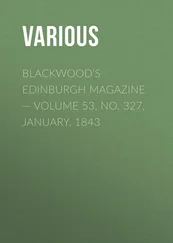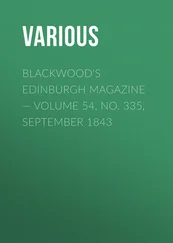Various - Blackwood's Edinburgh Magazine, Volume 60, No. 369, July 1846
Здесь есть возможность читать онлайн «Various - Blackwood's Edinburgh Magazine, Volume 60, No. 369, July 1846» — ознакомительный отрывок электронной книги совершенно бесплатно, а после прочтения отрывка купить полную версию. В некоторых случаях можно слушать аудио, скачать через торрент в формате fb2 и присутствует краткое содержание. Издательство: Иностранный паблик, Жанр: periodic, foreign_edu, Путешествия и география, на английском языке. Описание произведения, (предисловие) а так же отзывы посетителей доступны на портале библиотеки ЛибКат.
- Название:Blackwood's Edinburgh Magazine, Volume 60, No. 369, July 1846
- Автор:
- Издательство:Иностранный паблик
- Жанр:
- Год:неизвестен
- ISBN:нет данных
- Рейтинг книги:3 / 5. Голосов: 1
-
Избранное:Добавить в избранное
- Отзывы:
-
Ваша оценка:
- 60
- 1
- 2
- 3
- 4
- 5
Blackwood's Edinburgh Magazine, Volume 60, No. 369, July 1846: краткое содержание, описание и аннотация
Предлагаем к чтению аннотацию, описание, краткое содержание или предисловие (зависит от того, что написал сам автор книги «Blackwood's Edinburgh Magazine, Volume 60, No. 369, July 1846»). Если вы не нашли необходимую информацию о книге — напишите в комментариях, мы постараемся отыскать её.
Blackwood's Edinburgh Magazine, Volume 60, No. 369, July 1846 — читать онлайн ознакомительный отрывок
Ниже представлен текст книги, разбитый по страницам. Система сохранения места последней прочитанной страницы, позволяет с удобством читать онлайн бесплатно книгу «Blackwood's Edinburgh Magazine, Volume 60, No. 369, July 1846», без необходимости каждый раз заново искать на чём Вы остановились. Поставьте закладку, и сможете в любой момент перейти на страницу, на которой закончили чтение.
Интервал:
Закладка:
This respectable priest was by no means singular in his love of the chase, of which frequent examples are to be found in Peru. On reaching Quipico, the most easterly plantation in the beautiful valley of Huaura, Dr. Tschudi had scarcely entered the courtyard when he was surrounded by upwards of fifty greyhounds, whilst from every quarter others came springing towards him. They were the remains of a pack that had belonged to one Castilla, recently the owner of the plantation, and whose usual establishment consisted of two to three hundred of these dogs, with which he every day went coursing. The strictest discipline was kept up amongst this lightfooted multitude. At stated hours a bell summoned them to their meals, and in the kennel stood a gibbet, as a warning to the lazy or perverse. One day, when Castilla was out hunting, an Indian came up, with an ordinary-looking crossbred dog. In spite of his looks this dog out-stripped the whole pack, and pulled down the roebuck. Castilla immediately purchased him at the enormous price of three hundred and fifty dollars. A few days afterwards he again went out with his best hounds and his new acquisition. The leashes were slipped, and the greyhounds went off like the wind, but the crossbreed remained quietly by the horses. The same afternoon he was hung up to the gallows, an example to his fellows.
The whole extent of the Peruvian coast, from its northern to its southern extremity, presents nearly the same aspect; vast deserts of sand, varied by fruitful valleys, with their villages and plantations; seaport towns there where nature or commerce has encouraged their foundation; alternate insupportable heat and damp fog; scarcity of men; crumbling monuments of a period of riches and greatness. In the sandy plains it is no unusual occurrence for travellers to lose their way and perish for thirst. In that fervent and unhealthy climate, human strength rapidly gives way before want of food and water. In the year 1823 a transport carrying a regiment of dragoons, three hundred and twenty strong, stranded on the coast near Pisco. The soldiers got on shore, and wandered for thirty-six hours through the sand-waste, out of which they were unable to find their way. At the end of that time they were met by a number of horsemen with water and food, who had been sent out from Pisco to seek them, but already one hundred and fifty of the unfortunates had died of thirst and weariness, and fifty more expired upon the following day. Forty-eight hours' wandering in those arid deserts, deprived of food and drink, is certain death to the strongest man. Rivers are scarce, and even where the bed of a stream is found, it is in many instances dry during the greater part of the year. The traveller's danger is increased by the shifting nature of the sand, which the wind raises in enormous clouds, and in columns eighty to one hundred feet high. The medanos are another strange phenomenon of these dangerous wilds. They are sandhills in the form of a crescent, ten to twenty feet high, and with a sharp crest. Their base is moveable, and when impelled by a tolerably strong wind, they wander rapidly over the desert; the smaller ones, more easily propelled, preceding the large. The latter, however, after a time, prevent the current of air from reaching the former – take the wind out of their sails, it may be said – and then run over and crush them, themselves breaking up at the same time. In a few hours, what was previously a level, is often covered with ranges of hillocks, hindering a view of the horizon, and bewildering the most experienced wanderers through these perilous regions. In November the summer begins. The scorching rays of the sun break through the grey covering of the heavens, and threaten to consume, by their intensity, the entire vegetable and animal creation. Not a plant finds nourishment, nor a beast food upon the parched and glowing soil; no bird or insect floats upon the sultry air. Only in the upper regions is seen the majestic condor, flying towards the ocean. All life and movement is now confined to the coast. Troops of vultures assemble around the stranded carcases of sea monsters; otters and seals bask beneath the cliffs; variegated lizards scamper over the sand-heaps, and busy crabs and sea-spiders dig into the damp shore. In May the scene changes. A thin veil of mist spreads over sea and coast, gradually thickening, until in October the sun again dispels it. At the beginning and end of this winter, as it is called, the fog generally rises at nine or ten in the morning, and is again dissipated at three in the afternoon. It is thickest in August and September, when, for weeks together, it does not lift. It never changes into rain, but only into a fine penetrating mist, called the garua . On many parts of the Peruvian coast, it never rains, excepting after a very violent earthquake, and even then not always. The usual height of the fog from the ground is seven or eight hundred feet. It never exceeds a height of twelve hundred feet, nor is found at all beyond a few miles from the coast, at which distance it is replaced by violent rains. The boundary line between rain and fog may be determined with almost mathematical accuracy. Dr Tschudi visited two plantations, one about six leagues from Lima, the other in the neighbourhood of Huacho, one half of which was annually watered by the garuas , and the other half by rain. A wall was built upon the line where one mode of irrigation ceased and the other began.
The province of Yca, whose soil is sandy, and to all appearance incapable of producing any description of vegetation, is devoted to the culture of the vine, which perfectly succeeds there. The young plants are set half a foot deep in the sand, and left to themselves; they speedily put forth leaves, and yield a luxuriant crop of grapes, remarkable for flavour and juiciness. These are mostly used for brandy, with which the whole of Peru and great part of Chili are supplied from the valley of Yca. It is of excellent quality, especially a sort made from muscatel grapes, and called aguardiente de Italia . Very little wine is made, except by one planter, Don Domingo Elias, who has attempted it after the European fashion. The result has been a wine resembling Madeira and Teneriffe, only much more fiery, and containing a larger proportion of alcohol. The brandy was formerly conveyed to the coast in huge earthen botijas , capable of containing one hundred and fifty to one hundred and seventy-five pounds weight of the liquor; but these were continually broken, chiefly by the thirsty mules across which they were slung like panniers, and who, when rushing in crowds to the watering-places, invariably smashed a number of them against each other. To remedy this the brandy-growers have adopted the use of goat-skins; and the manner in which, upon many plantations, these are prepared, is as frightful a piece of barbarity as can well be imagined. A negro hangs up the goat, alive, by the horns, makes a circular cut through the skin of the neck, and strips the hide from the agonized beast, which is only killed when completely flayed. The pretext for this execrable cruelty is, that the skin comes off more easily, and is found more durable. It is to be hoped that the planters will have sufficient humanity speedily to do away with so horrible a practice.
The negro carnival, which Dr Tschudi witnessed at Yca, appears to us, of the two, a more civilized performance than the Creole carnival at Lima. In various of the streets large arches, tastefully decorated with ribands, are erected; the negresses and zambas dance beneath then; whilst the allotted task of the men is to gallop through without being stopped. If the women succeed in checking the horse, and pulling the rider out of the saddle, the latter has to pay a fine, and gets laughed at to boot. It is difficult to know which to admire most; the speed of the horses, the skill of the riders, or the daring of the women, who throw themselves upon the horse as he comes on at full gallop. As the horsemen approach, they are pelted with unripe oranges, which, thrown by a strong-armed zamba, are capable of inflicting tolerably hard knocks. Dr Tschudi saw one negro who, during a whole hour, galloped backwards and forwards without being stopped, and concluded by giving an extraordinary proof of muscular strength. At the very moment that he passed under the arch, he stooped forward over his horse's neck, caught up a negress under each arm, and rode off with them!
Читать дальшеИнтервал:
Закладка:
Похожие книги на «Blackwood's Edinburgh Magazine, Volume 60, No. 369, July 1846»
Представляем Вашему вниманию похожие книги на «Blackwood's Edinburgh Magazine, Volume 60, No. 369, July 1846» списком для выбора. Мы отобрали схожую по названию и смыслу литературу в надежде предоставить читателям больше вариантов отыскать новые, интересные, ещё непрочитанные произведения.
Обсуждение, отзывы о книге «Blackwood's Edinburgh Magazine, Volume 60, No. 369, July 1846» и просто собственные мнения читателей. Оставьте ваши комментарии, напишите, что Вы думаете о произведении, его смысле или главных героях. Укажите что конкретно понравилось, а что нет, и почему Вы так считаете.












